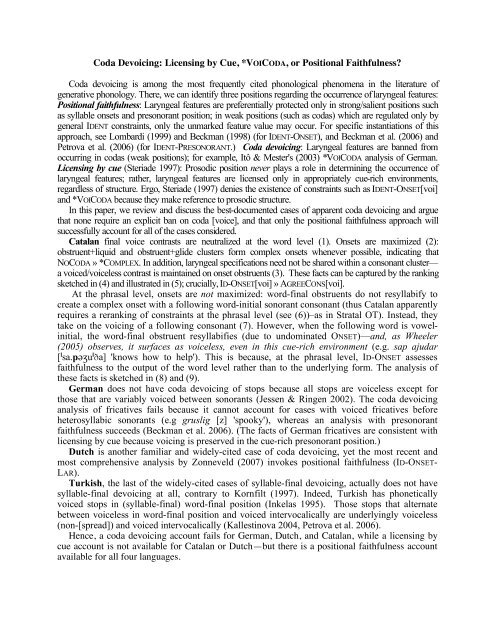Coda Devoicing - CUNY Phonology Forum
Coda Devoicing - CUNY Phonology Forum
Coda Devoicing - CUNY Phonology Forum
You also want an ePaper? Increase the reach of your titles
YUMPU automatically turns print PDFs into web optimized ePapers that Google loves.
<strong>Coda</strong> <strong>Devoicing</strong>: Licensing by Cue, *VOICODA, or Positional Faithfulness?<strong>Coda</strong> devoicing is among the most frequently cited phonological phenomena in the literature ofgenerative phonology. There, we can identify three positions regarding the occurrence of laryngeal features:Positional faithfulness: Laryngeal features are preferentially protected only in strong/salient positions suchas syllable onsets and presonorant position; in weak positions (such as codas) which are regulated only bygeneral IDENT constraints, only the unmarked feature value may occur. For specific instantiations of thisapproach, see Lombardi (1999) and Beckman (1998) (for IDENT-ONSET), and Beckman et al. (2006) andPetrova et al. (2006) (for IDENT-PRESONORANT.) <strong>Coda</strong> devoicing: Laryngeal features are banned fromoccurring in codas (weak positions); for example, Itô & Mester's (2003) *VOICODA analysis of German.Licensing by cue (Steriade 1997): Prosodic position never plays a role in determining the occurrence oflaryngeal features; rather, laryngeal features are licensed only in appropriately cue-rich environments,regardless of structure. Ergo, Steriade (1997) denies the existence of constraints such as IDENT-ONSET[voi]and *VOICODA because they make reference to prosodic structure.In this paper, we review and discuss the best-documented cases of apparent coda devoicing and arguethat none require an explicit ban on coda [voice], and that only the positional faithfulness approach willsuccessfully account for all of the cases considered.Catalan final voice contrasts are neutralized at the word level (1). Onsets are maximized (2):obstruent+liquid and obstruent+glide clusters form complex onsets whenever possible, indicating thatNOCODA » *COMPLEX. In addition, laryngeal specifications need not be shared within a consonant cluster—a voiced/voiceless contrast is maintained on onset obstruents (3). These facts can be captured by the rankingsketched in (4) and illustrated in (5); crucially, ID-ONSET[voi] » AGREECONS[voi].At the phrasal level, onsets are not maximized: word-final obstruents do not resyllabify tocreate a complex onset with a following word-initial sonorant consonant (thus Catalan apparentlyrequires a reranking of constraints at the phrasal level (see (6))–as in Stratal OT). Instead, theytake on the voicing of a following consonant (7). However, when the following word is vowelinitial,the word-final obstruent resyllabifies (due to undominated ONSET)—and, as Wheeler(2005) observes, it surfaces as voiceless, even in this cue-rich environment (e.g. sap ajudar[«sa.p\!u«"a] 'knows how to help'). This is because, at the phrasal level, ID-ONSET assessesfaithfulness to the output of the word level rather than to the underlying form. The analysis ofthese facts is sketched in (8) and (9).German does not have coda devoicing of stops because all stops are voiceless except forthose that are variably voiced between sonorants (Jessen & Ringen 2002). The coda devoicinganalysis of fricatives fails because it cannot account for cases with voiced fricatives beforeheterosyllabic sonorants (e.g gruslig [z] 'spooky'), whereas an analysis with presonorantfaithfulness succeeds (Beckman et al. 2006). (The facts of German fricatives are consistent withlicensing by cue because voicing is preserved in the cue-rich presonorant position.)Dutch is another familiar and widely-cited case of coda devoicing, yet the most recent andmost comprehensive analysis by Zonneveld (2007) invokes positional faithfulness (ID-ONSET-LAR).Turkish, the last of the widely-cited cases of syllable-final devoicing, actually does not havesyllable-final devoicing at all, contrary to Kornfilt (1997). Indeed, Turkish has phoneticallyvoiced stops in (syllable-final) word-final position (Inkelas 1995). Those stops that alternatebetween voiceless in word-final position and voiced intervocalically are underlyingly voiceless(non-[spread]) and voiced intervocalically (Kallestinova 2004, Petrova et al. 2006).Hence, a coda devoicing account fails for German, Dutch, and Catalan, while a licensing bycue account is not available for Catalan or Dutch—but there is a positional faithfulness accountavailable for all four languages.
Data and Examples(1) [«tip] 'fed up M', [«ti.p\] 'fed up F' vs. [«sap] 'knows', [«sa.!´m] 'know 1PL.PRS.IND' (Wheeler2005)(2) [«te.kl\] 'key', [u.«!li.kw\] 'oblique F', [s\«tem.b‰\] 'September' (Wheeler 2005)(3) [«p‰øw] 'enough' vs [«b‰øw] 'broth', [«sen.t‰\] 'centre' vs. [«s´n.d‰\] 'ash',[p‰u.«pi˜.kw\]'nearby' vs. [«Òe˜.gw\] 'tongue' (Wheeler 2005)(4) ONSET, NOCODA » *COMP; ID-ONSET[voi] » AGREECONS[voi] » *VDOBS » ID[voi](5) te/kl/a NOCODA ID- AGREECONS[voi] *VDOBS IDENT[voi] *COMPLEXONSET[voi]! te.[kl]a * *te.[gl]a *! * * *te[k.l]a *! *(6) ONSET, *COMP » NOCODA; ID-ONSET[voi] » AGREECONS[voi] » *VDOBS » ID[voi](7) [«sab.«riw‰\] sap riure ‘knows how to laugh' (c.f. [«sap] ‘knows’, [«sa.!´m] ‘know1PL.PRS.IND’), [«pøg.«lø!ik] poc lògic ‘not very logical’ (c.f. [«pøk] ‘little’) (Wheeler 2005)(8) sap#riure *COMPLEX NOCODA ID-ONSET[voi] AGREECONS[voi] *VDOBS.b‰ *! * *.p‰ *! *! b.‰ * *p.‰ * *!(9) sap#ajudar ONSET NOCODA ID-ONSET[voi] AGREECONS[voi] *VDOBS! .pa.ba *! *p.a *! *ReferencesBeckman, Jill N. (1998) Positional Faithfulness. PhD dissertation, University of Massachusetts.Beckman, Jill, Michael Jessen, & Catherine Ringen (2006) "Phonetic variation and phonological theory:German fricative voicing," in D. Baumer, D. Montero, and M. Scanlon (eds.), Proceedings of theWCCFL 25, Somerville, MA: Cascadilla Proceedings Project, 76-86.Inkelas, Sharon. (1995) The Consequences of Optimization for Underspecification,” in NELS 23.Itô, Junko & Armin Mester. (2003) "On the sources of opacity in Optimality Theory: coda processes inGerman," in C. Fery (ed.), The Syllable in Optimality Theory. Cambridge: Cambridge University Press.Jessen, Michael & Catherine Ringen (2002) "Laryngeal features in German," <strong>Phonology</strong> 19.2:189-218.Kallestinova, Elena (2004) "Voice and aspiration of stops in Turkish," in Grzegorz Dogil (ed.), Special Issueon Voice, Folia Linguistica 28, 43-62.Kornfilt, Jaklin (1997) Turkish. New York: Routledge.Lombardi, Linda (1999) "Positional faithfulness and voicing assimilation in Optimality Theory," NLLT17:276-302.Petrova, Olga, Rosemary Plapp, Catherine Ringen, & Szilárd Szentgyörgyi (2006) "Voice and aspiration:Evidence from Russian, Hungarian, German, Swedish, and Turkish." The Linguistic Review 23:1-35.Steriade, Donca (1997) "Phonetics in <strong>Phonology</strong>: The case of laryngeal neutralization." Ms., UCLA.Wheeler, Max W. (2005) The <strong>Phonology</strong> of Catalan. Oxford: Oxford University Press.Zonneveld, Wim (2007) "Issues in Dutch devoicing: Positional faithfulness, positional markedness, andlocal conjunction." Ms. to appear in E.J. van der Torre and J.M. van de Weijer (eds.), Voicing in Dutch,Amsterdam: John Benjamins.
















